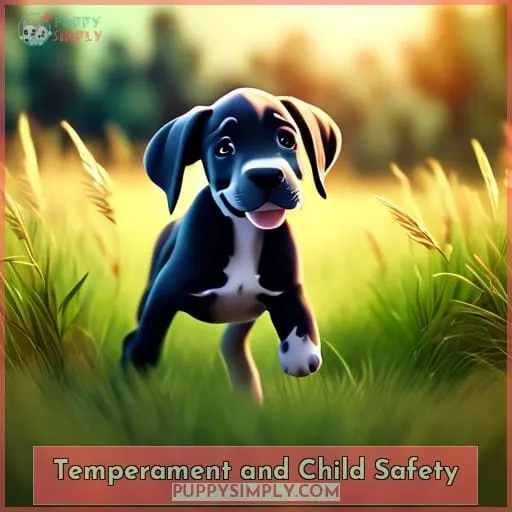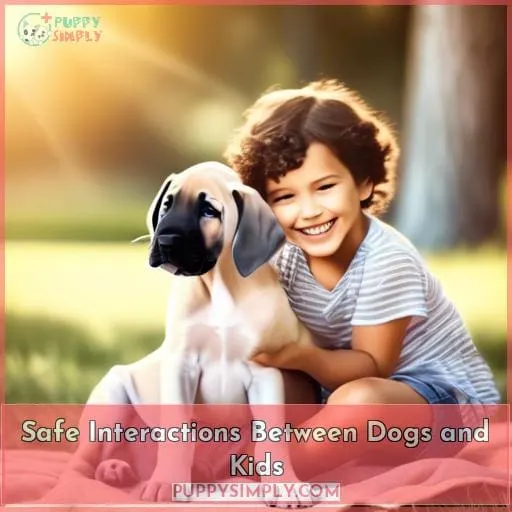This site is supported by our readers. We may earn a commission, at no cost to you, if you purchase through links.
 Considering a Great Dane puppy for your family? You’re in for a treat!
Considering a Great Dane puppy for your family? You’re in for a treat!
These gentle giants are known for their affectionate nature and patience, making them fantastic companions for children.
Despite their towering size, Great Danes are calm, loving, and protective, always ready to play gently or stand guard over their little human friends.
However, their size does require some considerations—like ensuring they don’t accidentally knock over smaller kids during play.
With the right training and socialization, Great Danes can be the perfect addition to families, offering both fun and a sense of security.
Let’s dive into what makes Great Dane puppies and kids such a great match, and how to foster a safe and happy relationship between them.
Table Of Contents
- Key Takeaways
- Great Dane Size and Kids
- Temperament and Child Safety
- Training and Socialization
- Managing Shedding and Allergies
- Health Considerations
- Safe Interactions Between Dogs and Kids
- Professional Guidance and Support
- Frequently Asked Questions (FAQs)
- How can I prepare my home environment to accommodate a Great Dane puppy’s growth and energy levels?
- What are the best practices for introducing a Great Dane puppy to a newborn baby in the household?
- How can I ensure my Great Dane puppy is getting the right amount of exercise without risking damage to their developing bones?
- What are some effective ways to manage a Great Dane’s large appetite and food costs within a family budget?
- How can I teach my children to recognize and respond to a Great Dane’s body language and signs of discomfort?
- Conclusion
Key Takeaways
- Great Dane puppies are known for their affectionate nature and patience, making them excellent companions for children. However, due to their large size, supervision is necessary during playtime to prevent accidental knockdowns.
- Training and socializing a Great Dane puppy with children is crucial for harmonious family life. This includes teaching essential commands, using positive reinforcement techniques, and implementing behavioral conditioning techniques.
- Regular grooming practices, including brushing and using specific supplements, are key to managing shedding and allergies in Great Dane puppies. Hypoallergenic diets and dander control methods can also help reduce allergens.
- Health considerations for Great Danes include planning meals to prevent bloat and being proactive about their musculoskeletal health. Regular vet check-ups, appropriate nutrition, and teaching children to recognize warning signs from the dog are important for managing these risks.
Great Dane Size and Kids
When it comes to Great Danes and kids, their size is a significant factor to consider.
These gentle giants, while affectionate and calm, can easily knock over small children due to their sheer size and strength.
Therefore, it’s crucial to supervise interactions between your Great Dane and young children to prevent any accidental knockdowns.
Potential for Accidental Knockdowns
Awareness of the substantial size of Great Danes is crucial when considering their interactions with children, as their sheer physicality poses a risk of accidental knockdowns during moments of excitement or play.
To ensure the safety of both your gentle giant and your little ones, consider implementing the following supervision strategies:
-
Create a Dedicated Space:
- Allocate a specific area in your home where your Great Dane can relax without the fear of accidentally knocking over a child.
- This helps in minimizing risks during their zoomies or when they simply forget their size.
-
Teach Children About Safe Interactions:
- Educate your kids on how to approach and play with Great Dane puppies safely.
- This includes not running towards the dog, avoiding sudden movements, and understanding the dog’s body language to prevent collisions.
-
Supervise Playtime Closely:
- Always be present during interactions between your Great Dane and children.
- This allows you to intervene quickly if play becomes too rough, ensuring safety precautions are followed and preventing accidental interactions that could lead to knockdowns.
Supervision Around Young Children
Given their size, you’ll need to keep a close eye on your Great Dane when they’re around young children to prevent any accidental mishaps.
Active supervision is key, setting boundaries for both the kids and your gentle giant.
Teach communication cues to ensure safe playtime.
Create dog-friendly spaces where your Great Dane can retreat if needed.
| Active Supervision | Setting Boundaries | Safe Playtime |
|---|---|---|
| Watch interactions closely. | Define safe zones for play. | Teach kids to respect the dog’s space. |
| Teach kids to interpret dog cues. | Establish rules for interaction. | Encourage gentle play. |
| Ensure dog has a retreat space. | Reinforce boundaries consistently. | Monitor playtime to prevent rough play. |
Temperament and Child Safety
Great Dane puppies, known for their calm and even-tempered nature, are generally good with kids.
It’s crucial, however, to teach your children to interact with these gentle giants in a safe and respectful manner.
Understanding and respecting each other’s boundaries ensures a harmonious relationship between your Great Dane puppy and your kids.
Calm and Even-Tempered Nature
Transitioning from the physical size of Great Danes, it’s crucial to understand their temperament, especially around children.
Despite their imposing stature, Great Danes are known for their calm, even-tempered nature, which can be a significant advantage when they interact with kids.
These Gentle Giants embody calm companionship, making them ideal family pets.
However, temperament training and exercise are essential to maintain this serene demeanor.
Encouraging respectful interaction between your children and your Great Dane, along with seeking behavioral consultation when needed, ensures a harmonious household.
Importance of Respectful Interaction
Respectful interaction between children and Great Danes is crucial for ensuring the safety and well-being of both.
Respectful Boundaries:
-
Teach kids to approach dogs calmly, respecting their space.
Communication Cues:
-
Help children understand dogs’ signals, like growling, for mutual understanding.
Trust Building:
-
Encourage gentle handling to foster trust and prevent health issues like hip dysplasia.
Muzzle Training:
- Consider this as a safety measure, especially during shedding periods when dogs may be more irritable.
Training and Socialization
Training and socializing your Great Dane puppy with kids is crucial for a harmonious family life.
It’s essential to teach essential commands for safety, using positive reinforcement techniques to encourage good behavior.
This approach not only helps in molding a well-behaved dog but also strengthens the bond between your Great Dane and the children in your family.
Essential Commands for Safety
After understanding the calm and even-tempered nature of Great Danes, it’s now time to delve into the crucial aspect of training and socialization.
As you continue on this journey with your Great Dane, mastering essential commands for safety becomes a key focus.
Obedience basics aren’t just about good manners; they’re about preventing accidents and ensuring a harmonious home.
Start with safety commands like ‘sit’, ‘stay’, ‘come’, and ‘down’, which are the bedrock of behavioral boundaries.
These commands help manage your dog’s size and strength, especially around children.
Consistent training tips, such as positive reinforcement and patience, are vital.
With a lifespan that can stretch up to a decade, investing time in training early on sets the stage for a lifetime of safe and enjoyable companionship.
Positive Reinforcement Techniques
You’ll find that a number of positive reinforcement techniques can significantly enhance your Great Dane’s trainability, making interactions with children safer and more enjoyable.
- Behavior Modification: Use rewards to encourage good behavior, discouraging unwanted actions.
- Reinforcement Strategies: Consistent praise and treats can lead to training success, reinforcing desired behaviors.
- Behavioral Conditioning: Implement learning techniques that associate positive experiences with child interaction, fostering a calm response.
Managing Shedding and Allergies
When it comes to managing shedding and allergies in Great Dane puppies, regular grooming practices and allergy management strategies are key.
Great Danes aren’t hypoallergenic and do shed, but consistent care can significantly reduce allergens in your home.
Brushing your puppy regularly, along with employing strategies like using specific supplements and maintaining a clean environment, can help keep both shedding and allergic reactions to a minimum.
Regular Grooming Practices
While managing your Great Dane’s shedding might seem like a daunting task due to their size, it’s actually quite manageable with regular grooming practices.
Regular brushing is key to shedding control, helping to remove loose hair, distribute natural oils, and stimulate the skin.
Invest in quality grooming tools, such as a soft-bristle brush or a grooming glove, to avoid irritating their sensitive skin.
Regular grooming not only aids in coat maintenance but also promotes skin health.
Allergy Management Strategies
To manage your Great Dane’s shedding and reduce allergy triggers, you’ll need to implement several strategies:
- Regular, allergy-friendly grooming can help control dander.
- Hypoallergenic diets may reduce allergenic proteins in your dog’s saliva.
Consider dander control methods:
- Frequent vacuuming
- Using allergy-safe bedding
Additionally, air purification techniques can help keep your home’s environment clean and allergen-free.
Health Considerations
When considering a Great Dane puppy for a family with kids, it’s crucial to:
- Plan meals carefully to prevent bloat, a potentially fatal condition.
- Be proactive about their musculoskeletal health, as these large dogs are prone to joint issues.
Regular vet check-ups and appropriate nutrition can help manage these risks and ensure a healthy life for your Great Dane.
Preventing Bloat With Meal Planning
In addressing the health considerations for Great Danes, particularly the prevention of bloat through meal planning, it’s crucial to understand that with their susceptibility to Gastric Dilatation-Volvulus (GDV), or bloat, managing their diet is key to their well-being.
By feeding your Great Dane smaller, more frequent meals throughout the day, you’re taking a significant step towards minimizing the risk of this life-threatening condition. This approach helps prevent the stomach from becoming overly full and reduces the chance of it twisting, which is the primary concern with bloat.
- Dietary Management: Carefully balance your Great Dane’s diet with appropriate nutrients.
- Meal Frequency: Spread meals out to two or three times daily.
- Portion Control: Serve smaller portions to avoid overfilling the stomach.
- Preventive Measures: Incorporate regular exercise to aid digestion.
- Bloat Prevention: Avoid vigorous activity right after meals to reduce risk.
Addressing Musculoskeletal Issues
Your Great Dane’s joint health is a crucial aspect of their overall well-being, especially considering their susceptibility to musculoskeletal issues like arthritis and hip dysplasia.
To support their joints, consider preventive measures such as:
- Weight management
- Regular check-ups
- Physiotherapy techniques
Appropriate exercise regimens can also help:
- Daily walks
- Controlled play
- Low-impact activities
Dietary adjustments can also play a role in maintaining joint health. Explore joint support options, including supplements that provide essential nutrients:
- Glucosamine supplements
- Omega fatty acids
- Chondroitin sulfate
Safe Interactions Between Dogs and Kids
Ensuring safe interactions between Great Dane puppies and kids is crucial for a harmonious household.
It’s important to teach your children to recognize warning signs from the dog, such as growling or retreating, which indicate discomfort.
Additionally, creating safe spaces for your Great Dane to retreat to when they need quiet time can help prevent any potential incidents.
Teaching Kids to Recognize Warning Signs
Moving on from health considerations, it’s crucial you teach your kids to pick up on the warning signs that a Great Dane may be feeling stressed or uncomfortable.
Recognizing cues in dog body language can prevent mishaps.
Here’s what to look out for:
- Growling or baring teeth indicates a need for space.
- A tucked tail or ears pinned back suggest discomfort.
- Stiffening of the body means the dog is on high alert.
Child education on these safety measures helps set boundaries for harmonious living.
Creating Safe Spaces for the Dog
Providing your dog with a dedicated space will help them feel secure and comfortable in your home.
It’s crucial to establish quiet retreats where your Great Dane can unwind without disturbance.
These tranquil havens aren’t just comfort zones for your pet; they’re also dog-friendly zones that reinforce secure boundaries, ensuring everyone in the family feels at ease.
Benefits:
For Your Dog:
- Emotional Security
- Personal Territory
- Stress Relief
-
Independence
For Your Family:
- Peace of Mind
- Behavior Control
- Safety Assurance
- Respect for Privacy
- Health Improvement
- Harmonious Living
- Confidence Boost
Professional Guidance and Support
If you’re noticing challenges as your Great Dane puppy interacts with your kids, it’s wise to consult a behaviorist.
They’ll offer tailored advice and strategies, considering your dog’s unique personality and the breed’s traits.
Professional training programs can also provide structured guidance, helping your puppy develop into a well-mannered family member.
When to Consult a Behaviorist
Understanding when to seek professional help from a behaviorist can be crucial in ensuring a harmonious relationship between your Great Dane and children.
Here are key moments for a behaviorist consultation:
- Persistent Aggression or Fear: If your dog shows unchanging signs of aggression or fear towards family members.
- Difficulty in Family Integration: When efforts to integrate the dog with children don’t improve dynamics.
- Ineffective Training Methods: If traditional training doesn’t address specific behavioral issues, indicating a need for tailored intervention strategies and a thorough behavioral assessment.
Benefits of Professional Training Programs
Seeking professional training programs offers a structured approach to integrating your Great Dane into the family, especially when it comes to ensuring safe interactions with children.
These programs provide a wealth of benefits, including:
- Behavior Modification: Expert trainers employ proven techniques to modify undesirable behaviors, promoting harmony within the household.
- Training Techniques: Learn effective training techniques tailored to your Great Dane’s unique personality and needs, fostering a well-behaved and obedient companion.
- Behavior Assessment: In-depth behavior assessment helps identify the root cause of problematic behaviors, enabling targeted interventions for lasting change.
- Professional Guidance: Experienced trainers provide personalized guidance and support, addressing your specific concerns and helping you navigate challenges.
- Skill Development: Develop essential skills for effectively communicating with your Great Dane, strengthening the bond between you and your furry friend.
Professional training programs empower you with the knowledge and skills necessary to raise a well-behaved Great Dane that’s a cherished member of your family.
Frequently Asked Questions (FAQs)
How can I prepare my home environment to accommodate a Great Dane puppy’s growth and energy levels?
To prepare your home for a Great Dane puppy’s growth and energy:
- Ensure ample indoor space for movement.
- Secure a large, durable crate for safety.
- Create a safe, enclosed outdoor area for exercise.
Regularly engage in gentle handling and socialization activities to foster calm behavior.
What are the best practices for introducing a Great Dane puppy to a newborn baby in the household?
Gently introducing a Great Dane puppy to a newborn is like conducting a symphony of love.
Start by setting boundaries and creating a safe space for your pup.
Gradually introduce the baby’s scent and sounds, rewarding calm behavior.
How can I ensure my Great Dane puppy is getting the right amount of exercise without risking damage to their developing bones?
To ensure your Great Dane puppy gets the right amount of exercise without harming their developing bones:
- Stick to short, gentle walks of 5-15 minutes.
- Avoid forced exercise like running or biking.
Gradually increase activity as they grow, focusing on:
- Play
- Training for mental stimulation
What are some effective ways to manage a Great Dane’s large appetite and food costs within a family budget?
Budget wisely:
- Opt for high-quality food in smaller portions.
- Supplement with healthy homemade meals.
- Avoid overfeeding to maintain a healthy weight.
How can I teach my children to recognize and respond to a Great Dane’s body language and signs of discomfort?
Teach your kids to be dog detectives.
Observing the Great Dane’s tail wags, ear positions, and body posture to decode their feelings and respond with care.
Conclusion
Ironically, while Great Dane puppies may seem like a towering challenge, they’re often a perfect fit for families with kids.
Your gentle giant will need guidance, but with proper training and care, they’ll be a loving guardian for your little ones.
Remember to supervise interactions, manage shedding, and address health needs to ensure a harmonious home.
Embrace the journey with your Great Dane—they’re not just good with kids, they’re great companions for life.













